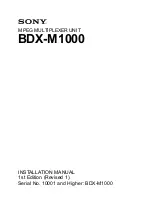Reviews:
No comments
Related manuals for EX310

KANE505
Brand: Kane Pages: 24

ethos 5030
Brand: MTI Pages: 9

Mult-K
Brand: KRON MEDIDORES Pages: 4

PASAR 223
Brand: Acer Pages: 12

HI-3702
Brand: ETS-Lindgren Pages: 34

BDX-M1000
Brand: Sony Pages: 36

BKPF-105A
Brand: Sony Pages: 40

U3606A
Brand: Keysight Pages: 293

DM-2A POCKET-PRO
Brand: A.W. Sperry Instruments Pages: 10

U2741A
Brand: Keysight Pages: 169

MS8228
Brand: Mastech Pages: 26

RC831-240E
Brand: Raisecom Pages: 29

19B
Brand: UYIGAO Pages: 36

3000-524
Brand: Giga-tronics Pages: 21

HI98199
Brand: Hanna Instruments Pages: 46

DC-MULTISER-1UH-DIN
Brand: KAEL Pages: 13

22-602
Brand: Radio Shack Pages: 20

8540
Brand: Paradyne Pages: 161

















